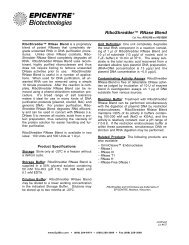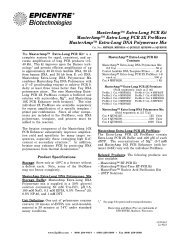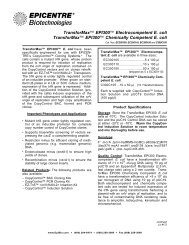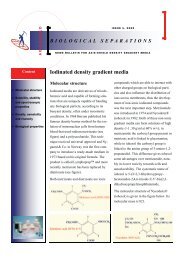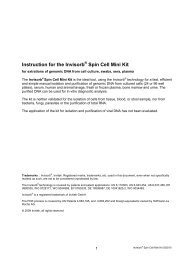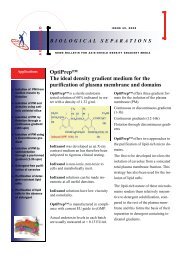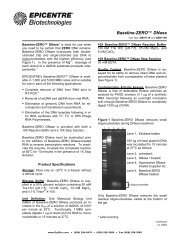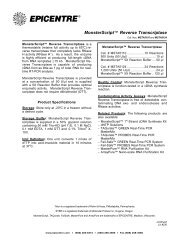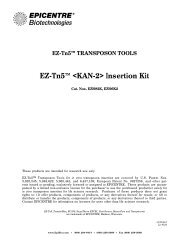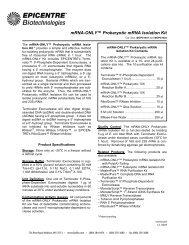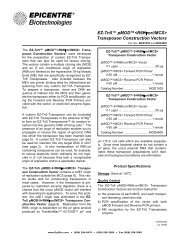RNA Cell HTS 96 Kits
RNA Cell HTS 96 Kits
RNA Cell HTS 96 Kits
- No tags were found...
Create successful ePaper yourself
Turn your PDF publications into a flip-book with our unique Google optimized e-Paper software.
Kit content of InviTrap ® <strong>RNA</strong> <strong>Cell</strong> <strong>HTS</strong> <strong>96</strong> Kit/ VStore all kit components at room temperatureStore 1 M DTT at - 20°C (not provided)1 x <strong>96</strong> <strong>RNA</strong> preps 2 x <strong>96</strong> <strong>RNA</strong> preps 4 x <strong>96</strong> <strong>RNA</strong> preps 24 x <strong>96</strong> <strong>RNA</strong> prepsCatalog Number 7061310100 7061310200 7061310300 7061310400Lysis Solution S 1 x 30 ml 60 ml 120 ml 3 x 250 mlBinding Buffer R9 ml(final volume 30 ml)18 ml(final volume 60 ml)36 ml(final volume 120 ml)2 x 105 ml(final volume 2x350 ml)Wash Buffer R140 ml(final volume 80 ml)80 ml(final volume 160 ml)2 x 80 ml(final volume 2x160 ml)2 x 400 ml(final volume 2x800 ml)Wash Buffer R220 ml(final volume 100 ml)40 ml(final volume 200 ml)2 x 40 mlfinal volume 2 x200 ml2 x 200 mlfinal volume 2x1000 mlElution Buffer R 10 ml 20 ml 2 x 20 ml 200 mlDNA-Binding-Plate A<strong>RNA</strong>-Binding-PlateCollection Plate,1 mlMicrotiter Platewith Cover1 2 4 6 x 41 2 4 6 x 41 2 4 6 x 41 2 4 6 x 4Sealing Foils 2 4 8 24Manual 1 1 1 1Initial Steps Add 21 ml <strong>96</strong>-100%Ethanol to each bottleBinding Buffer R.Add 40 ml <strong>96</strong>-100%Ethanol to each bottleWash Buffer R1.Mix shortly and keepthe bottle always firmlyclosed!Add 80 ml <strong>96</strong>-100%Ethanol to each bottleWash Buffer R2.Mix shortly and keepthe bottle always firmlyclosed!Add 42 ml <strong>96</strong>-100%Ethanol to each bottleBinding Buffer R.Add 80 ml <strong>96</strong>-100%Ethanol to each bottleWash Buffer R1.Mix shortly and keepthe bottle alwaysfirmly closed!Add 160 ml <strong>96</strong>-100% Ethanol to eachbottle Wash BufferR2.Mix shortly and keepthe bottle alwaysfirmly closed!Add 84 ml <strong>96</strong>-100%Ethanol to each bottleBinding Buffer R.Add 80 ml <strong>96</strong>-100%Ethanol to each bottleWash Buffer R1.Mix shortly and keepthe bottle always firmlyclosed!Add 160 ml <strong>96</strong>-100%Ethanol to each bottleWash Buffer R2.Mix shortly and keepthe bottle always firmlyclosed!Add 245 ml <strong>96</strong>-100%Ethanol to each bottleBinding Buffer R.Add 350 ml <strong>96</strong>-100%Ethanol to each bottleWash Buffer R1.Mix shortly and keepthe bottle always firmlyclosed!Add 800 ml <strong>96</strong>-100%Ethanol to each bottleWash Buffer R2.Mix shortly and keepthe bottle always firmlyclosed!Adjust Lysis Solution TR with 1/100 volume of 1M DTT. Due to the instability of dissolved DTT underoxidative conditions do not mix the whole Lysis Solution TR with DTT in case of the kits with 50 and 250preparations. We recommend the preparation of a volume DTT-containing Lysis Solution TR shortlybefore carrying out the purifications adapted to the number of samples that will be processed. Store theremaining Lysis Solution TR and DTT separately in accordance to the storage instructions (see “Storage”,page 4).It is possible to replace DTT by β-Mercaptoethanol. In that case adjust Lysis Solution TR with 1/100volume of β-Mercaptoethanol as described above.3 InviTrap ® <strong>RNA</strong> <strong>Cell</strong> <strong>HTS</strong> <strong>96</strong> Kit/ C and V 0810
Product use limitationThe kit is neither validated for the isolation of total <strong>RNA</strong> from serum, plasma, blood, tissue, nor forbacteria, yeast, or viruses. The performance of the kit in isolating and purifying total <strong>RNA</strong> fromfecal samples has not been evaluated.The kit was not tested on its ability to desalinate <strong>RNA</strong> or for <strong>RNA</strong> purification from enzymaticreactions, like DNase digestion mixtures, Proteinase digestion, <strong>RNA</strong> ligation, or labeling reactions.The included chemicals are for one time use, plates can be use several times, if not all wells wereused in first run and unused wells were sealed during the process and no contamination occurred.When changing the starting material or the flow trace, no guarantee in operability is issued.The user is responsible to validate the performance of the Invitek kits for any particular use, since theperformance characteristics of our kits have not been validated for any specific application. Invitek kitsmay be used in clinical diagnostic laboratory systems after the laboratory has validated the completediagnostic system as required by CLIA’ 88 regulations in the U.S. or equivalents in other countries.All products sold by Invitek are subjected to extensive quality control procedures (according to ISO9001-2000 and ISO EN 13485:2003) and are warranted to perform as described when used correctly.Any problems should be reported immediately.The chemicals and plastic parts are for laboratory use only, they must be stored in the laboratoryand must not used for purposes other than intended.The kit contents are unfit for consumption.Safety informationWhen working with chemicals, always wear a suitable lab coat, disposable gloves, and protectivegoggles and avoid skin contact. Heed the legal requirements for working with biological material!For more information, please consult the appropriate material safety data sheets (MSDS). These areavailable online in convenient and compact PDF format at www.invitek.de for each Invitek kit and kitcomponent.If the buffer bottles are damaged or leaking, wear gloves and protective goggles when discarding thebottles in order to avoid any injuries.Invitek has not tested the liquid waste generated by the InviTrap ® <strong>RNA</strong> <strong>Cell</strong> <strong>HTS</strong> <strong>96</strong>-Kit proceduresfor residual infectious materials. Contamination of the liquid waste with residual infectious materials ishighly unlikely, but cannot be excluded completely. Therefore, liquid waste must be consideredinfectious and be handled and discarded according to local safety regulation.Below is listed European Community risk and safety phrases for the components of the InviTrap ®<strong>RNA</strong> <strong>Cell</strong> <strong>HTS</strong> <strong>96</strong> Kit to which they apply.Lysis Solution SWash Buffer R1Xn contains: Guanidinthiocyanate Xn contains: Guanidinthiocyanateharmfulharmful(R20/21/22-32, S2-13)(R20/21/22-32-52/53, S13-61)R20/21/22harmful by inhalation, in contact with skin and if swallowed.R32contact with acids liberates very toxic gas.R52/53 harmful to aquatic organisms, may cause long-term adverse effects in the aquatic environment.S2keep out of the reach of children.S13keep away from food, drink and animal feeding stuff.S61avoid release to the environment. Refer to special instructions/safety data sheet.Emergency medical information in English and German can be obtained 24 hours a day from:Poison Information Center Freiburg, Germany: Tel.: ++49 761-192405 InviTrap ® <strong>RNA</strong> <strong>Cell</strong> <strong>HTS</strong> <strong>96</strong> Kit/ C and V 0810
Product characteristic of the InviTrap ® <strong>RNA</strong> <strong>Cell</strong> <strong>HTS</strong> <strong>96</strong>-KitStarting material Yield Timeup to 5 x 10 5 human oranimal cells(cultured cells)max: 15-20 µge.g.10 - 15 µg total <strong>RNA</strong> from5 x10 5 NIH 3T3 fibroblasts5 µg total <strong>RNA</strong> from 1 x 10 5 MRC 5 cellsca. 35 min. using a centrifugeca. 40 min. using a vacuum manifoldca. 30 min. using centrifuge incombination with a vacuum manifoldThe InviTrap ® <strong>RNA</strong> <strong>Cell</strong> <strong>HTS</strong> <strong>96</strong> Kit/ C provide a fast and efficient way for the isolation of highquality total <strong>RNA</strong> from <strong>96</strong> – 192 <strong>RNA</strong> samples from max. 5 x 10 5 human or animal cells (cellculture), inter alia for field of research like agent-screenings, therapy monitoring, basic research,expressions profiling, and molecular diagnostic.The InviTrap ® <strong>RNA</strong> <strong>Cell</strong> <strong>HTS</strong> <strong>96</strong> Kit/ C is designed for use on a centrifuge, the InviTrap ® <strong>RNA</strong><strong>Cell</strong> <strong>HTS</strong> <strong>96</strong> Kit/ V for use in combination with the Invisorb ® <strong>96</strong> Vacuum Manifold.In less than 30 min. 192 samples can be processed gaining highly purified <strong>RNA</strong>.Special buffer conditions guarantee an efficient lysis of the starting material and an inactivation ofendogenous RNases. Genomic DNA-contaminations are almost completely separated from thetotal <strong>RNA</strong> by binding to a newly developed carrier substance.No enzymatic step, like DNase-digestion, to remove contaminating genomic DNA is necessary.Subsequent <strong>RNA</strong> is bound onto the membrane of the <strong>RNA</strong> Binding-Plate. Contaminants areremoved by following wash steps and high purified <strong>RNA</strong> can be eluted in small volume of RNasefree water.The extracted <strong>RNA</strong> contains enriched m<strong>RNA</strong>. The particle size distribution of purified <strong>RNA</strong> issimilar to those, gained using a CsCl – gradient.The procedures require minimal interaction by the user, allowing safe handling of potentiallyinfectious samples. The procedures are optimized to avoid sample-to-sample cross-contamination.Due to the high purity, the isolated total <strong>RNA</strong> is ready to use for a broad panel of downstreamapplications (see below) or can be stored at –80°C for subsequent use.Downstream Application○○○○○○RT-PCRDDRT-PCRReal-time PCR (quantitative RT-PCR, like TaqMan ® und LightCycler ® technologies)cDNA synthesesMirco array analysisNorthern Blot analysisNo toxic or hazardous chemicals like phenol/chloroform or ß-Mercaptoethanol are used. Traditionaltime-killing procedures can be replaced using the InviTrap ® <strong>RNA</strong> <strong>Cell</strong> <strong>HTS</strong> <strong>96</strong> Kit.For automated high throughput needs Invitek offers the InviTrap ® <strong>RNA</strong> <strong>Cell</strong> <strong>HTS</strong> <strong>96</strong> Kit/ R (seeorder information).Invitek also offers a column based system for the puification of <strong>RNA</strong> from cells in a single tubeformat. For small amounts of cells the InviTrap ® Spin <strong>Cell</strong> <strong>RNA</strong> Mini Kit and for larger samplequantity the InviTrap ® Spin <strong>Cell</strong> <strong>RNA</strong> Midi Kit, using the same procedure.If you are interested in using the kit on a laboratory workstation, please do not hesitate to contactour technical support (++49 (0)30-9489-2910/ 2901/ 2907).6 InviTrap ® <strong>RNA</strong> <strong>Cell</strong> <strong>HTS</strong> <strong>96</strong> Kit/ C and V 0810
Principle and procedureThe InviTrap ® <strong>RNA</strong> <strong>Cell</strong> <strong>HTS</strong> <strong>96</strong> Kit procedure comprises following steps:1. lysis of cells2. selective binding of the genomic DNA to specific carrier and separation of contaminating DNAon the surface of the DNA Binding Plate3. remaining sample transferring into the wells of the <strong>RNA</strong> binding plate, followed by theadjustment of the binding conditions4. binding of the total <strong>RNA</strong> to the membrane5. washing of the membrane and elimination of contaminants and ethanol6. elution of high pure total <strong>RNA</strong>After lysis the DNA binds onto membrane of the DNA binding plate, after contaminations andenzyme inhibitors are efficiently removed during the following two wash steps and highly purified<strong>RNA</strong> is eluted in Elution Buffer or water.This manual contains 3 protocols (page 13-17).Sampling and storage of starting material:Best results are obtained using freshly extracted cells. As long as samples aren’t shock frosted orare inserted in RNase inhibitors or denaturing reagents, <strong>RNA</strong> is not secured. Therefore it isessential, that cells are immediately flash frozen after cell harvest and are stored at –80°C. <strong>RNA</strong>purification should be processed as soon as possible. <strong>Cell</strong>s also can be stored in Lysis Solution Sat –80°C after cell lysis.<strong>RNA</strong> from deep frozen samples is stable for months.LysisAfter removing of the culture medium, cells are directly charged with DTT-containing LysisSolution S and thoroughly mixed. Due to the strong denaturing conditions cells are quickly lysed,simultaneously RNases are inactivated and the <strong>RNA</strong> is secured. The <strong>RNA</strong> is secured. DTT isadded to inactivate the RNases by cleaving intramolecular disulfide bridges.Binding and removal of DNAUnder these conditons DNA during lysis is bound to Lysis Solution S contained carrier.Lysate will be completely transferred to an InviTrap ® <strong>96</strong> Micro Filter Plate and centrifuged. DNAremains bound to the surface of the membrane of the DNA-Binding-Plate A. The <strong>RNA</strong>-containingsolution is located in the eluate.Binding total <strong>RNA</strong>After adding Binding Buffer R to the eluates, those are completely transferred onto the<strong>RNA</strong> – Binding Plate and the <strong>RNA</strong> is bound on the membrane.Removing residual contaminantsContaminants are efficiently washed away using Wash Buffer R1 and R2, while the <strong>RNA</strong>remains bound to the membrane.ElutionTotal <strong>RNA</strong> is eluted from the membrane using 60 - 80 µl Elution Buffer R (RNase free water). Theeluted <strong>RNA</strong> is ready for use in different subsequent tests.7 InviTrap ® <strong>RNA</strong> <strong>Cell</strong> <strong>HTS</strong> <strong>96</strong> Kit/ C and V 0810
Important notesImportant points before starting a protocolAfter receiving the kit, check the kit components for damage. If buffer bottles are damaged, contactthe Invitek Technical Services or your local distributor. In case of liquid spillage, refer to “Safetyinformation” (see page 5). Do not use damaged kit components, since their use may lead to poorkit performance.Sample quantityThe InviTrap ® <strong>RNA</strong> purification procedure is optimized for the use of 50 to max. 5 x 10 5 cells.Which cell amount shouldn’t exceed, therefore direct cell counting is recommend. Table 1 may beused as a guide.Growth area and number of HeLa cells in various cell-culture plates<strong>Cell</strong> culture plate Growth area in cm 2 * Number of cell**<strong>96</strong> well48 well12 well6 well0,3 – 0,61.04.09,54-5 x 10 41,3 x 10 55.0 x 10 51,2 x 10 6*) Growth area varies slightly depending on the supplier**) Confluent growth is assumed. Values are reported per wellThe well membranes have a maximum binding capacity of approx. 100 µg, but actual yields will bedifferent depending on the cell line even for the same amount of cells.If more than 5 x 10 5 cells are to be processed, it is recommend to split the sample. Doubling theused buffer volumes prior <strong>RNA</strong> binding onto the membrane, doesn’t’ lead to designated result ineither case, particularly with respect to removal of contaminating DNA. Volumes of Wash- andElution Buffer needn’t to be aligned.Depending on used cell line, lysates may become viscous using large cell quantity and this maycause clogged membranes. High Viscosity always leads to lower yield and quality of isolated <strong>RNA</strong>.Therefore it is recommend to perform preliminary viscosity analysis of the desired cell linedepending on cell quantity, as well as analyzing <strong>RNA</strong> yield and purity. More than 1 x 10 6 cellsshould not be used.Average total <strong>RNA</strong> yield depending on cell line using the InviTrap® <strong>RNA</strong> <strong>Cell</strong> <strong>HTS</strong> <strong>96</strong> Kit.<strong>Cell</strong> Line Source yield in µg for 1 x 10 5 cellsHeLaJurkatMRC 5NIH3T3human cervical carcinomahuman T-cell leukemiahumanhuman2.01,75.06,58 InviTrap ® <strong>RNA</strong> <strong>Cell</strong> <strong>HTS</strong> <strong>96</strong> Kit/ C and V 0810
Preparing reagents and buffers1 x <strong>96</strong> total <strong>RNA</strong>-extractions:add 21 ml <strong>96</strong>-100% ethanol to the bottle Binding Buffer Radd 40 ml of <strong>96</strong>-100% ethanol to the bottle Wash Buffer R1; Mix shortly and keep the bottlealways firmly closedadd 80 ml of <strong>96</strong>-100% ethanol to the bottle Wash Buffer R2. mix shortly and keep the bottlealways firmly closedadjust Lysis Solution S with 1/100 volume of 1 M DTT*2 x <strong>96</strong> total <strong>RNA</strong>-extractions:add 42 ml <strong>96</strong>-100% ethanol to the bottle Binding Buffer Radd 80 ml of <strong>96</strong>-100% ethanol the bottle Wash BufferR1; mix shortly and keep the bottlealways firmly closedadd 80 ml of <strong>96</strong>-100% ethanol to each bottle Wash BufferR2; mix shortly and keep the bottle alwaysfirmly closedadjust Lysis Solution S with 1/100 volume of 1 M DTT*4 x <strong>96</strong> total <strong>RNA</strong>-extractions:add 84 ml <strong>96</strong>-100% ethanol to the bottle Binding BufferRadd 80 ml of <strong>96</strong>-100% ethanol to the bottle Wash BufferR1; mix shortly and keep the bottlealways firmly closedadd 160 ml of <strong>96</strong>-100% ethanol to the bottle Wash Buffer R2; mix shortly and keep the bottle alwaysfirmly closedadjust Lysis Solution S with 1/100 volume of 1 M DTT*24 x <strong>96</strong> total <strong>RNA</strong>-extractions:add 245 ml <strong>96</strong>-100% ethanol to the bottle Binding BufferRadd 350 ml of <strong>96</strong>-100% ethanol to the bottle Wash Buffer R1; mix shortly and keep the bottle alwaysfirmly closedadd 800 ml of <strong>96</strong>-100% ethanol to the bottle Wash Buffer R2; mix shortly and keep the bottle alwaysfirmly closedadjust Lysis Solution S with 1/100 volume of 1 M DTT*Harvesting cells<strong>Cell</strong>s grown in a monolayer: <strong>Cell</strong>s grown in a monolayer in <strong>96</strong>-well plates can be lysed directly in thewells. Completely remove medium by pipetting<strong>Cell</strong>s grown in suspension: Transfer aliquots of up to 5 x 10 5 cells into a <strong>96</strong>-well plate. Centrifuge at240 x g (1.500 rpm) for 5 min and completely remove medium by pipetting.Note:Incomplete removal of cell culture medium will inhibit partially lysis and dilute the lysate which willaffect the yield and quality of the resulting <strong>RNA</strong>.Lysis Solution SShake Lysis Solution S gently before use to homogenize the carrier! Wait a short time because offoam formation!<strong>Cell</strong> lysates stored in Lysis Solution S are stable at –80°C for several months.Adjust Lysis Solution S with 1/100 volume of 1 M DTT. Due to the instability of dissolved DTTunder oxidative conditions do not mix the whole Lysis Solution TR with DTT in case of the kitswith 50 and 250 preparations. We recommend the preparation of a volume DTT-containing LysisSolution TR shortly before carrying out the purifications adapted to the number of samples that willbe processed. Store the remaining Lysis Solution S and DTT separately in accordance to thestorage instructions (see “Storage”, page 4).It is possible to replace DTT by β-Mercaptoethanol. In that case adjust Lysis Solution TR with1/100 volume of β-Mercaptoethanol as described above.9 InviTrap ® <strong>RNA</strong> <strong>Cell</strong> <strong>HTS</strong> <strong>96</strong> Kit/ C and V 0810
Equipment and reagents to be supplied by userWhen working with chemicals, always wear a suitable lab coat, disposable gloves, and protectivegoggles. For more information, please consult the appropriate material safety data sheets(MSDSs).(See our web page : www.invitek.de)○○○○○○○○○○measuring cylinder (250 ml)disposable glovesmultichannel pipet with tipsreagents reservoirs for multichannel pipets<strong>96</strong>-100% ethanoloptional: DNase A (10 mg/ml)optional: centrifugeoptional: Manifoldcentrifuge: output ≥ 2.000 x g is necessary○ Sigma-Centrifuge 4-15C or centrifuge 4K15C with plate-rotor 2 x <strong>96</strong> or other rotors○ Eppendorf Centrifuge 5804 / 5804 R / 5810 / 5810 R with Deepwell-Plate-Rotor (A-2-DWP)DTTPossible supplier:Eppendorf AG22331Hamburg, GermanyTel.: +49 (0) 40 53801 0Fax: +49 (0) 40 53801 556E-Mail: eppendorf@eppendorf.comInternet: www.eppendorf.comSIGMA Laborzentrifugen GmbH37507 Osterode am Harz, GermanyTel.: +49-5522-5007-0Fax: +49-5522-5007-12E-Mail: info@sigma-zentrifugen.deInternet: www.sigma-zentrifugen.deManifold:Invisorb ® <strong>96</strong> Vacuum Manifold or Manifolds from other supplier Vacuum pumpor another vacuum source, which develop a vacuum pressure of about 200 mbar *).Possible supplier:KNF Neuberger GmbH79112 Freiburg i.Br., GermanyTel.: +49 (0) 7664 5909 0Fax: +49 (0)7664 5909-99E-Mail: info@knf.deInternet: www.knf.deVACUUBRAND GMBH+CO KG97866 Wertheim, GermanyTel. ++49 (0) 9342 808 0Fax ++49 (0) 9342 59880E-Mail: info@vacuubrand.deInternet: www.vacuubrand.deNote: *) 200 mbar = 200hPa = 150 mmHg10 InviTrap ® <strong>RNA</strong> <strong>Cell</strong> <strong>HTS</strong> <strong>96</strong> Kit/ C and V 0810
Handling optionsEach of the protocol in this instruction book is provided with three different handling options, usinga centrifuge, vacuum technology, or a combination of centrifuge and vacuum technology. Eachhandling option provides high yields of high-quality <strong>RNA</strong>.1. Use of a centrifuge (spin technology) (see page 14)The InviTrap ® <strong>RNA</strong> <strong>Cell</strong> <strong>HTS</strong> <strong>96</strong> Kit/ C provide a fast and efficient way for the isolation of highquality total <strong>RNA</strong> from <strong>96</strong> – 192 <strong>RNA</strong> samples from max. 5 x 10 5 human or animal cells (cellculture) using a centrifuge (spin technology), all protocol steps are performed in the centrifugerecommended on page 11.2. Use of a vacuum manifold (vacuum technology) (see page 16)Using the Invisorb ® <strong>96</strong> Vacuum Manifold is a quick way to carry out the <strong>RNA</strong> isolation. Up to<strong>96</strong> <strong>RNA</strong> samples can be processed in 40 minutes. Using two vacuum manifolds to process two<strong>96</strong> plates in parallel allows processing of up to 192 <strong>RNA</strong> samples in 45 minutes.<strong>RNA</strong> isolated using vacuum technology can be used in any enzymatic and non-enzymaticapplication (e.g. northern, dot, and slot blot analysis including quantitative RT–PCR analysis byTaqMan technology.3. Use of a combination of vacuum manifold and centrifuge (vacuum/ spin technology)(see page 18)Using a centrifuge in combination with the Invisorb ® <strong>96</strong> Vacuum Manifold is the quickestway to isolate <strong>RNA</strong> for <strong>96</strong> in parallel.The lyses step and final wash step including membrane drying, and the elution step areperformed in the centrifuge. All other steps are performed on the vacuum manifold. The PlateRotor 2 x <strong>96</strong> holds two InviTrap <strong>RNA</strong> plates, allowing up to 192 <strong>RNA</strong> samples to be prepared inonly 30- 35 minutes.Residual traces of salt are removed by centrifugation in the final wash step.Vacuum/ Spin technology isolated <strong>RNA</strong> can be used in any enzymatic or non-enzymaticdownstream application including quantitative RT–PCR analysis by TaqMan technology.11 InviTrap ® <strong>RNA</strong> <strong>Cell</strong> <strong>HTS</strong> <strong>96</strong> Kit/ C and V 0810
Scheme of the InviTrap ® <strong>RNA</strong> <strong>Cell</strong> <strong>HTS</strong> <strong>96</strong> Kit/ CPlease read protocols prior the start of the preparationRemoving the culture medium and cell extractionAdd 250 µl DTT-containing Lysis Solution SMix thoroughly, 20 sec.Place the DNA Binding Plate in a 0.5 ml Collection PlateTransfer lysates in DNA Binding PlateIncubate for 1 min., seal with a foilCentrifuge DNA Binding Plate/ 2ml Collection Plate for 3 min. at4.000 U/min.Discard DNA Binding PlateAdd 230 µl Binding Buffer R to the eluated lysateMix thoroughly by pipetting up and downPlace <strong>RNA</strong> Binding Plate in a 2.0 ml Collection PlateTransfer the eluates in the <strong>RNA</strong> Binding PlateIncubate for 1 min., seal with a foilCentrifugate <strong>RNA</strong> Binding Plate/2ml Collection Plate for 3 mi.n at4.000 U/min.Remove foilAdd 600 µl Wash Buffer R 1, sealingCentrifuge DNA Binding Plate/2ml Collection Plate for 3 min at4.000 U/minremove foil, discard eluatsAdd 400 µl Wash Buffer R 2, sealingCentrifuge DNA Binding Plate/2ml Collection Plate for 3 min at4.000 U/minremove foil, discard eluatsAdd 400 µl Wash Buffer R 2, sealingCentrifuge <strong>RNA</strong> Binding Plate/2ml Collection Plate at min 4000U/min for 10 min for ethanolremoval, remove foil, discard eluatPlace <strong>RNA</strong> Binding Plate onto RNase free Microtiter PlateAdd 60-80 µl Elution Buffer R, incubate for 2 min, sealingCentrifuge <strong>RNA</strong> Binding Plate/ Microtiter Plate for 3 min at 4.000U/minDiscard <strong>RNA</strong> Binding PlateSeal Microtiter plate, place on ice or store at – 80°C12 InviTrap ® <strong>RNA</strong> <strong>Cell</strong> <strong>HTS</strong> <strong>96</strong> Kit/ C and V 0810
Protocol 1: <strong>RNA</strong> Isolation from 50 – 1 x 10 5 human or animal cellsusing a centrifugePlease read the instructions carefully and conduct the prepared procedure.Important:Transfer the needed amount of Elution Buffer D into a 2.0 ml Receive Tube(not included in the kit) and place the tube at 56°C .1. Add 250 µl DTT-containing Lysis Solution S to each well of the Microtiter Plate with the cells.Shake thoroughly for 20 sec. while keeping the plate flat on the bench. Alternatively it is possibleto mix the samples thoroughly by using a shaker for microtiter plates or by pipetting up and down.Note:Shake Lysis Solution S gently before use! Wait a short time because of foam formation!<strong>Cell</strong> lysates in Lysis Solution S can be stored at –80°C for several months.2. Place the DNA Binding Plate A on top of a 0.5 ml Collection Plate.3. Apply the lysates (230 µl) from step 1 into the wells of the DNA Binding Plate A and incubate for 1min.4. Seal the DNA Binding Plate A with a Sealing Foil.5. Load the DNA Binding Plate A/ 0.5 ml Collection Plate into the holder and place the wholeassembly in the rotor bucket.6. Centrifuge at 1.700 x g (4.000 rpm) for 3 min. at room temperature (RT).7. Discard the DNA Binding Plate A and take the 0.5 ml Collection Plate out of the centrifuge.Note: Take care not to wet the rims of the wells to avoid cross-contamination in this and also in followingsteps.8. Add 230 µl of Binding Buffer R to the <strong>RNA</strong>-containing lysates into each well of the 0.5 mlCollection Plate and mix thoroughly by pipetting up and down.9. Place the <strong>RNA</strong>-Binding Plate on top of a 2.0 ml Collection Plate.10. Apply the lysates (460 µl) from step 8into the wells of the <strong>RNA</strong>-Binding Plate and incubate for 1min at RT.11. Seal the <strong>RNA</strong>-Binding Plate with a new Sealing Foil. Load the <strong>RNA</strong>-Binding Plate/ 2.0 mlCollection Plate into the holder and place the whole assembly in the rotor bucket. Centrifuge at1.700 x g (4.000 rpm) for 3 min. at RT. Take the DNA-Binding Plate/ 2.0 ml Collection Plate out ofthe centrifuge and remove the Sealing Foil.12. Add 600 µl Wash Buffer R1 to each well of the <strong>RNA</strong>-Binding Plate. Seal the <strong>RNA</strong>-Binding Platewith a new Sealing Foil. Load the <strong>RNA</strong>-Binding Plate/2.0 ml Collection Plate into the holder andplace the whole assembly in the rotor bucket. Centrifuge at 1.700 x g (4.000 rpm) for 3 min at RT.13. Take the <strong>RNA</strong>-Binding Plate out of the centrifuge, remove the Sealing Foil and place on a cleanpaper towel. Take the 2.0 ml Collection Plate out of the centrifuge and discard flow-through. Drythe upper site of the 2.0 ml Collection Plate with a clean paper towel.14. Place the <strong>RNA</strong>-Binding Plate again on top of the 2.0 ml collection plate.15. Add 400 µl Wash Buffer R2 to each well of the <strong>RNA</strong>-Binding Plate. Seal the <strong>RNA</strong>-Binding Platewith a new sealing foil. Load the <strong>RNA</strong>-Binding Plate/ 2.0 ml Collection Plate into the holder andplace the whole assembly in the rotor bucket. Centrifuge at 1.700 x g (4.000 rpm) for 3 min at RT.Take the <strong>RNA</strong>-Binding Plate/ 2.0 ml collection plate out of the centrifuge and remove Sealing Foil.13 InviTrap ® <strong>RNA</strong> <strong>Cell</strong> <strong>HTS</strong> <strong>96</strong> Kit/ C and V 0810
16. Add again 400 µl Wash Buffer R2 to each well of the <strong>RNA</strong>-Binding Plate. Seal the <strong>RNA</strong>-BindingPlate with a new sealing foil. Load the <strong>RNA</strong>-Binding Plate/ 2.0 ml Collection Plate into the holderand place the whole assembly in the rotor bucket. Centrifuge at maximum speed (minimum 1.700x g (4.000 rpm)) for 10 min at RT to eliminate any traces of ethanol.17. Take out the <strong>RNA</strong>-Binding Plate of the centrifuge, place it on a clean paper towel and removethe Sealing Foil.18. Place the <strong>RNA</strong>-Binding Plate on top of a RNase-free microtiter plate. To elute, pipet 60-80 µlElution Buffer R (RNase-free) directly onto the membrane in each well of the <strong>RNA</strong>-BindingPlate. Incubate for 2 min and seal the <strong>RNA</strong>-Binding Plate with a new Sealing Foil.19. Load the <strong>RNA</strong>-Binding Plate/ Microtiter Plate into the holder and place the whole assembly in therotor bucket. Centrifuge at 1.700 x g (4.000 rpm) for 3 min at RT. Discard the <strong>RNA</strong>-Binding Plateand take out the Microtiter Plate of the centrifuge. Cover the Microtiter Plate for storage. Store theextracted total <strong>RNA</strong> at –80°C.Notes on usage of centrifugesUsing InviTrap ® <strong>RNA</strong> <strong>Cell</strong> <strong>HTS</strong> <strong>96</strong> Kit/ C in the centrifuge (or in combination with vacuumtechnology) <strong>RNA</strong> can be isolated in parallel 2 x <strong>96</strong> samples and is ready to use for subsequentdownstream applications.For optimal use of the kit and for realizing of reproducible high yields centrifuges should be usedwith <strong>96</strong>-well deep well rotors, like the Sigma-Centrifuge 4-15C or Centrifuge 4K15C or theEppendorf 5804 R/ 5810 R centrifuge with Deepwell-Plate-Rotor (A-2-DWP). Furthermore anoutput above 1.700 x g (4.000 rpm) is necessary.Important:All centrifugation steps are performed at RT.Under no circumstances use plate rotor without <strong>96</strong> well plates, or with plates with varyingbuffer amounts never use only 1 plate in the centrifuge. Due to the unbalance the rotorwould destroyed under the high centrifugal forces.14 InviTrap ® <strong>RNA</strong> <strong>Cell</strong> <strong>HTS</strong> <strong>96</strong> Kit/ C and V 0810
Protocol 2: <strong>RNA</strong> Isolation using the Invisorb ® <strong>96</strong> Vacuum ManifoldFor reliable and fast isolation and purification of highly purified, DNA free <strong>RNA</strong> from fresh or frozenhuman or animal cell cultures.Please read protocols prior the start of the preparation and complete preparing steps, as wellas cell harvesting as afore mentioned (see page 12/ 13)1. Add 250 µl of DTT-containing Lysis Solution S to each well of the microtiter plate with thecells. Shake thoroughly for 20 sec while keeping the plate flat on the bench. Alternatively it ispossible to mix the samples thoroughly by using a shaker for Microtiter Plates or by pipettingup and downNote:Shake Lysis Solution S gently before use! Wait a short time because of foam formation!<strong>Cell</strong> lysates in Lysis Solution S can be stored at –80°C for several months.2. Place the 1 ml Collection Plate in the base of the Invisorb ® <strong>96</strong> Vacuum Manifold and close themanifold with the top plate. Place the DNA-Binding Plate onto the rubber joint of the Invisorb ® <strong>96</strong>Vacuum Manifold top plate.3. Apply the samples from step 1 (230 µl) into the wells of the DNA-Binding Plate. Incubate for 1min.4. Switch on vacuum source and apply vacuum for at least 3 min (max. 200 mbar *)) until thetransfer of the lysate into the wells of the 1 ml Collection Plate is complete. To remove adherentdrops from the outlets of the DNA-Binding Plate strike several times with the flat hand on the topof the DNA-Binding Plate. Switch off vacuum and ventilate the vacuum manifold. Take the DNA-Binding Plate out of the manifold very carefully in order to avoid cross-contaminations withadherent fluid. Discard the DNA-Binding Plate. Remove the manifold top plate from the base,take the 1 ml Collection Plate out of the manifold and place it on the bench.Note: *) 200 mbar = 200hPa = 150 mmHgNote: Make sure that the Invisorb ® <strong>96</strong> Vacuum Manifold is assembled correctly before loading.5. Add 230 µl of Binding Buffer R to the 1 ml Collection Plate and mix thoroughly by pipetting upand down.6. Place the waste tray inside the vacuum manifold and close the manifold with the top plate. Placethe <strong>RNA</strong>-Binding Plate onto the rubber joint of the Invisorb ® <strong>96</strong> Vacuum Manifold top plate.7. Apply the mixtures from step 5 completely into the wells of the <strong>RNA</strong>-Binding Plate and incubatefor 1 min.8. Switch on vacuum source and apply vacuum until the transfer of the lysate into the waste tray iscompletely (about 2 min). Switch off vacuum and ventilate the vacuum manifold.9. Add 600 µl Wash Buffer R1 to each well of the <strong>RNA</strong>-Binding Plate. Switch on vacuum sourceand apply vacuum until the transfer of the wash buffer into the waste tray will be completed(about 2 min). Switch off vacuum and ventilate the vacuum manifold.10. Add 400 µl Wash Buffer R2 to each well of the <strong>RNA</strong>-Binding Plate. Switch on vacuum sourceand apply vacuum until the transfer of the wash buffer into the waste tray is complete (about 2min). Switch off vacuum and ventilate the vacuum manifold.15 InviTrap ® <strong>RNA</strong> <strong>Cell</strong> <strong>HTS</strong> <strong>96</strong> Kit/ C and V 0810
11. Repeat this washing step by adding again 400 µl Wash Buffer R2 to each well of the <strong>RNA</strong>-Binding Plate. Switch on vacuum source and apply vacuum until the transfer of the wash bufferis complete (about 2 min). Switch off vacuum and ventilate the vacuum manifold.12. To remove adherent fluid, lift the <strong>RNA</strong>-Binding Plate from the InviTrap ® Top Plate and strike thebottom side of the <strong>RNA</strong>-Binding Plate on a stack of paper towels. Repeat several times until nofurther liquid is released onto the paper. Remove the manifold top plate from the base anddiscard the flow-through from the waste tray.13. Place the waste tray inside the vacuum manifold and close the manifold with the Top Plate. Placethe <strong>RNA</strong>-Binding Plate onto the rubber joint of the Invisorb ® <strong>96</strong> Vacuum Manifold top plate. Switchon vacuum source and apply vacuum for at least 20 min for complete removal of all ethanol.Switch off vacuum and ventilate the vacuum manifold. Take the <strong>RNA</strong>-Binding Plate out of themanifold and place it on a clean paper towel. Remove the manifold top plate and the waste tray.14. Place the spacer for Microtiter Plates (large spacer) followed by the Microtiter Plate inside thebase of the Invisorb ® <strong>96</strong> Vacuum Manifold and close the manifold with the top plate.15. Place the <strong>RNA</strong>-Binding Plate onto the rubber joint of the Invisorb ® <strong>96</strong> Vacuum Manifold Top Plate.For the elution of total <strong>RNA</strong> add 60-80 µl Elution Buffer R (RNase-free) directly onto themembrane in each well of the <strong>RNA</strong>-Binding Plate and incubate for 2 min.16. Switch on vacuum source and apply vacuum for at least 3 min until the transfer until the transferinto the wells of the Microtiter Plate is complete. To remove adherent drops from the outlets of the<strong>RNA</strong>-Binding Plate strike several times with the flat hand on the top of the <strong>RNA</strong>-Binding Plate.17. Switch off vacuum and ventilate the vacuum manifold. Take the <strong>RNA</strong>-Binding Plate verycarefully out of the manifold in order to avoid cross-contaminations with adherent fluid. Discardthe <strong>RNA</strong>-Binding Plate. Remove the manifold top plate from the base and take the MicrotiterPlate with the eluted total <strong>RNA</strong> out of the manifold. Cover the Microtiter Plate for storage (-80°C).Note: Invisorb ® <strong>96</strong> Vacuum Manifold – Please follow the instruction on page 20.Note: The Invisorb <strong>96</strong> Vacuum Manifold contains acrylglass. To avoid any Problem with the materialNote:1. Avoid a long incubation with ethanol or isopropanol containing solutions2. Clean up the manifold after using with water and dry it.3. Always use the waste tray.16 InviTrap ® <strong>RNA</strong> <strong>Cell</strong> <strong>HTS</strong> <strong>96</strong> Kit/ C and V 0810
Protocol 3: <strong>RNA</strong> Isolation from 50 – 1 x 10 5 human or animal cellsusing a centrifuge in combination with the Invisorb <strong>96</strong>Vacuum ManifoldsFor reliable and fast isolation and purification of high purified, DNA free <strong>RNA</strong> from fresh or frozenhuman or animal cell cultures.Please read protocols prior the start of the preparation and complete preparing steps, as wellas cell harvesting as aforementioned (see page 12/ 13)1. Add 250 µl of DTT-containing Lysis Solution S to each well of the microtiter plate with thecells. Shake thoroughly for 20 sec while keeping the plate flat on the bench. Alternatively it ispossible to mix the samples thoroughly by using a shaker for Microtiter Plates or by pipettingup and downNote:Shake Lysis Solution S gently before use! Wait a short time because of foam formation!<strong>Cell</strong> lysates in Lysis Solution S can be stored at –80°C for several months.2. Place the DNA-Binding Plate A on 0.5 ml Collection Plate3. Apply the samples from step 2 (230 µl) into the wells of the DNA-Binding Plate. Incubate for 1 minat room temperature.4. Seal the DNA Binding Plate A with a sealing foil.Load the DNA Binding Plate A/ 0.5 ml Collection Plate into the holder and place the wholeassembly in the rotor bucket.Centrifuge at 1.700 x g (4.000 rpm) for 3 min at room temperature (RT).Discard the DNA Binding Plate A and take the 0.5 ml Collection Plate out of the centrifuge.Note: Take care not to wet the rims of the wells to avoid cross-contamination in this and also in following steps.5. Add 230 µl of Binding Buffer R to the <strong>RNA</strong>-containing lysates into the 0.5 ml Collection Plateand mix thoroughly by pipetting up and down.6. Place the waste tray (or alternatively a 2.0 ml collection plate) inside the vacuum manifold.Place the <strong>RNA</strong>-Binding Plate in the top plate of the vacuum-manifold.7. Apply the lysates from step 5 completely into the wells of the <strong>RNA</strong>-Binding Plate and incubate for1 min.8. Switch on vacuum source and apply vacuum until the transfer of the lysate into the waste tray iscompletely (about 2 min). Switch off vacuum and ventilate the vacuum manifold9. Add 600 µl Wash Buffer R1 to each well of the <strong>RNA</strong> Binding Plate. Switch on vacuum sourceand apply vacuum until the transfer of the wash buffer into the waste tray will be completed(about 2 min). Switch off vacuum and ventilate the vacuum manifold10. Add 400 µl Wash Buffer R2 to each well of the <strong>RNA</strong>-Binding Plate. Switch on vacuum sourceand apply vacuum until the transfer of the wash buffer into the waste tray is complete (about 2min). Switch off vacuum and ventilate the vacuum manifold11. Repeat washing step by adding 400 µl Wash Buffer R2 to each well of the <strong>RNA</strong>-Binding Plate.Switch on vacuum source and apply vacuum until the transfer of the wash buffer into the wastetray is complete (about 2 min). Switch off vacuum and ventilate the vacuum manifold12. Place the <strong>RNA</strong>-Binding Plate on top of a 2.0 ml Collection Plate.Seal the <strong>RNA</strong> Binding Plate with a Sealing FoilLoad the <strong>RNA</strong>-Binding Plate/2.0 ml collection plate into the holder and place the wholeassembly in the rotor bucket17 InviTrap ® <strong>RNA</strong> <strong>Cell</strong> <strong>HTS</strong> <strong>96</strong> Kit/ C and V 0810
13. Centrifuge at 9.000 x g (6.200 rpm) for 10 – 15 min at room temperature (RT) to eliminate anytraces of ethanol. Take the <strong>RNA</strong>-Binding Plate out of the centrifuge, remove the Sealing Foil andplace it on a clean paper towel. Discard the 2.0 ml Collection Plate.14. Place <strong>RNA</strong> Binding Plate on top of a RNase-free microtiter plate. To elute, pipet 60-80 µl ElutionBuffer R directly onto the membrane in each well of the <strong>RNA</strong>-Binding Plate. Incubate for 2 minand seal the <strong>RNA</strong>-Binding Plate with a new a Sealing Foil.15. Load the <strong>RNA</strong>-Binding Plate/ Microtiter plate into the holder and place the whole assembly in therotor bucket. Centrifuge at 1.700 x g (4.000 rpm) for 3 min at RT. Discard the <strong>RNA</strong>-Binding Plateand take the Microtiter plate out of the centrifuge. Cover the Microtiter plate for storage. Store theextracted total <strong>RNA</strong> at –80°CNote: *) -200 mbar = -200hPa = 150 mmHg18 InviTrap ® <strong>RNA</strong> <strong>Cell</strong> <strong>HTS</strong> <strong>96</strong> Kit/ C and V 0810
Additional informationInvisorb ® <strong>96</strong> Vacuum Manifoldca3421bdManifold Base (1)Manifold Top Plate (2)Port (a),Adapter (b) (different options)○ Adapter (4)○ Adapter (6)○ Adapter (20)Waste Tray (c)Spacer (large) (d)Invisorb ® Spin Filters (3)Invisorb ® <strong>96</strong> Filter Microplate (4)Notes on usage of the Invisorb ® <strong>96</strong> Vacuum ManifoldThe Invisorb ® <strong>96</strong> Vacuum Manifold operates with a central vacuum system or a vacuum pump. Ifthe central vacuum system is instable or weak, it is recommended to use a vacuum pump with acapacity of 15 – 20 liter / min. Using a to weak vacuum leads to reduced DNA yield and purity.A vacuum of about -200 mbar (-2.0*10 4 Pa)* (difference to atmosphere) should be reached, whenthe Adapter + Invisorb ® Spin Filter or Invisorb ® <strong>96</strong> Filter Microplate (foil sealed) is used withthe manifold. To avoid damaging of plates and filters vacuum shouldn’t be stronger than -250 mbar(-2.5*10 4 Pa)* (difference to atmosphere). A vacuum weaker than -150 mbar (-1.5*10 4 Pa)*(difference to atmosphere) leads to a clearly elongation of processing time. In this case processingtimes mentioned in the protocol are no longer appropriate.Switch off the vacuum, when adding buffers during the several steps and ventilate the Manifold tokeep the same conditions for all samples. When working near the manifold wear protectivegoggles.Always place the Adapters or Invisorb ® <strong>96</strong> Filter Microplate with the slant corner on the rightside of the manifold, to avoid a mix-up of the samples. For safety reason do not use damagedplates!The manifold has only to be used in appropriate secure positions.*) Note: -150mbar = -150 hPA = 113 mm Hg-200mbar = -200 hPA = 150 mm Hg-250mbar = -250 hPA = 188 mm HgAfter usage the manifold must be cleaned and dried!!! It is essential to use the waste tray. Themanifold is partly made of acrylic glass and is therefore not resistant to longer contact with ethanol,methanol, alcoholic buffers or other organic solvents. So the manifold and the accessories have tobe washed with water after usage. Do not use abrasives. After cleaning the manifold andaccessories have to be dried with paper towel. If necessary use a towel with 70% ethanol.To guarantee durability the Manifold shouldn’t come in contact neither to silicone grease nor tolubricating grease. To promise durability of the rubber-joint, salts and buffers should be washedaway with water after usage, finally the rubber-joint has to be dried.19 InviTrap ® <strong>RNA</strong> <strong>Cell</strong> <strong>HTS</strong> <strong>96</strong> Kit/ C and V 0810
TroubleshootingProblem Cause Comments and suggestionslittle or no total <strong>RNA</strong>elutedinsufficient disruption orhomogenisationincomplete elutionbuffer temperature too lowunclean working, <strong>RNA</strong> digestioninappropriate sample extractionor storagereduce amount of starting material.Overloading reduces yieldprolong the incubation time with Elution BufferR to 5-10 min or repeat elution step once againall buffers must be at room temperaturethroughout the procedureuse RNase free tubes and pipet tips (seeHandling <strong>RNA</strong> in the Appendix)ensure that sample is flash frozen immediatelyafter extraction; store at –80°Clogged Spin-Filterinsufficient disruption orhomogenizationtoo much starting materialafter lysis spin lysate to pellet debris andcontinue with the protocol using thesupernatant.reduce amount of starting material.degraded <strong>RNA</strong>DNA-contaminationincorrect storage of startingmaterialRNase contaminations ofsolutions, receiver tubes etc.Lysis Solution S does notcontain DTTno optimal homogenization ofDNA binding carriertoo much starting materialelution volume too lowincomplete removal of DNAbinding carrierno DNase treatmentensure that the starting material is frozenimmediately in liquid N 2 and is storedcontinuously at –80°Cavoid thawing of the material; ensure that theprotocol, especially the first steps, has beenperformed quickly.use sterile, RNase-free filter-tips, before everypreparation clean up the pipettes, the devicesand the working place; always wear glovesensure that DTT has been added to the LysisSolution Sshake carefully Lysis Solution before usereduce amount of starting material.DNase digestion of the eluate containing thetotal <strong>RNA</strong>use elution volumes of 60 – 80 µl, repeat elutionstepfollow exactly the protocol and ensure theremoval of the DNA binding carrierif necessary after the InviTrap <strong>RNA</strong> ® <strong>96</strong>procedure, DNase digestion of the eluatecontaining the total <strong>RNA</strong>. After inactivatingDNase by heat treatment, the <strong>RNA</strong> can beeither used directly in the subsequentapplication without further treatment, orrepurified using the <strong>RNA</strong> cleanup protocollow A 260/A 280 value improper pH use 10 mM Tris-Cl, not RNase-free water, todilute the sample before measuring the puritylow well-to-wellreproducibilityelution volume too lowvacuum pressure too lowinhomogeneous cell growthuse elution volumes of 60 – 80 µl, repeat elutionstep (see protocols)a vacuum source capable of generating avacuum pressure of 200 mbar is necessary toachieve efficient <strong>RNA</strong> binding to the membrane,washing, and elution when using vacuum orvacuum/ spin technologyensure, that cells grow equably20 InviTrap ® <strong>RNA</strong> <strong>Cell</strong> <strong>HTS</strong> <strong>96</strong> Kit/ C and V 0810
AppendixGeneral notes on handling <strong>RNA</strong><strong>RNA</strong> is far less stable than DNA. It is very sensitive to degradation by endogenous RNases in thebiological material and exogenous RNases which are permanently present everywhere in the lab.To achieve satisfactory qualitative and quantitative results in <strong>RNA</strong> preparations, contaminationswith exogenous RNases has to be reduced as much as possible Avoid handling bacterial cultures,cell cultures or other biological sources of RNases in the same lab where the <strong>RNA</strong> purification is tobe carried out.All glassware should be treated before use to ensure that it is RNase-free. Glassware should becleaned with detergent, thoroughly rinsed and oven baked at 240°C for four or more hours beforeuse. Autoclaving alone will not completely inactivate many RNases. Oven baking will bothinactivate RNases and ensure that no other nucleic acids (such as Plasmid DNA) are present onthe surface of the glassware. You can also clean glassware with 0.1% DEPC (diethylpyrocarbonate). The glassware must stand 12 hours at 37°C and then be autoclaved or heated to100°C for 15 min to remove residual DEPC○○○○○○○○○○○○electrophoresis tanks should be cleaned with detergent solution (e.g. 0.5% SDS), thoroughlyrinsed with RNase-free water, and then rinsed with ethanol and allowed to drynon-disposable plasticware should be treated before use to ensure that it is RNase-free.Plasticware should be thoroughly rinsed with 0.1 M NaOH, 1 mM EDTA followed by RNasefreewater. You can also take chloroform-resistant plasticware rinsed with chloroform toinactivate RNasesall buffers must be prepared from DEPC-treated RNase-free ddH 2 Owhen working with chemicals, always wear a suitable lab coat, disposable gloves, andprotective goggleschange gloves frequently and keep tubes closedall centrifugation steps are carried out at room temperatureto avoid cross contamination cavity seams shouldn’t be moisted with fluidreduce the preparation time as much as possibleuse only sterile, disposable polypropylene tubes throughout the procedure. (these tubesare generally RNase free)keep isolated <strong>RNA</strong> on icedo not use kit components from other kits with the kit you are currently using, unless the lotnumbers are identicalto minimize the risk of infections from potentially infectious material, we recommend workingunder laminar air-flow until the samples are lysedThis kit should only be used by personnel trained in in vitro diagnostic laboratory practiceStorage of <strong>RNA</strong>Purified <strong>RNA</strong> can be stored –80°C and is stable for months and years, e.g. precipated and storedunder 70% ethanol.Quantification of <strong>RNA</strong>The concentration of <strong>RNA</strong> should be determinate by measuring the absorbance at 260 nm (A 260 ) inphoto spectrometer. Readings should be greater than 0.15 to ensure significance. An absorbanceof 1 unit at 260 nm corresponds to 40 µg of <strong>RNA</strong> per ml. This relation is valid only formeasurements at neutral pH. The ratio between absorbance values at 260 nm and 280 nm givesan estimate of <strong>RNA</strong> purity (see below)21 InviTrap ® <strong>RNA</strong> <strong>Cell</strong> <strong>HTS</strong> <strong>96</strong> Kit/ C and V 0810
When measuring <strong>RNA</strong> samples, make sure that cuvettes are RNase-free, esp. if the <strong>RNA</strong> is to berecovered after photo spectrometry. Thioas can be accomplished by washing cuvettes with 0.1NaOH, 1 mM EDTA folloed by washing with RNase-free water. Use buffer in which the <strong>RNA</strong> isdiluted to zero the photo spectrometer.An example of the calculation involved in <strong>RNA</strong> quantification:Volume of <strong>RNA</strong> sample 100 µlDilution = 20 µl of <strong>RNA</strong> sample + 180 µl of 10 mM Tris, pH 7.0 (1/10 dilution).Measure absorbance of diluted sample in a 0.2 ml cuvette (RNase free)A 260 = 0.2Concentration of <strong>RNA</strong> sampleTotal amount= 40 µg/ml * A 260 * dilution factor= 40 µg/ml * 0.2 * 10= 80 µg= concentration * volume of sample in ml= 80 µg/ml * 0.1 ml= 8 µg of <strong>RNA</strong>Purity of <strong>RNA</strong>The ratio of the readings at 260 nm and 280 nm (A 260 /A 280 ) provides an estimate of the purity of<strong>RNA</strong> with respect to the contaminants that absorb in the UV, such as protein. However, theA 260 /A 280 ratio is influenced considerably by pH. Since water is not buffered, the pH and theresulting A 260 /A 280 ratio can vary greatly. Lower pH results in lower A 260 /A 280 ratio and reducedsensitivity to protein contamination.* For accurate values, it is recommend to measure absorbancein 10 mM Tris Cl, pH 7.5. Pure <strong>RNA</strong> has an A 260 /A 280 ratio of 1.9-2.1** in 10 mM Tris Cl, pH 7.5.Always be sure to calibrate the spectrophotometer with the same solution.For determination of <strong>RNA</strong> concentration, however, it is recommend to dilute the sample in a bufferwith neutral pH since the relationship between absorbance and concentration (A 260 reading of 1 =40 µg/ml of <strong>RNA</strong>) is based on an extinction coefficient calculated for <strong>RNA</strong> at neutral pH.* Wilfinger, W.W.,Mackey, M., and Chomczynski, P. (1997) Effect of Ph and ionic strength on the spectrophotometricassessment of nucleic acid purity. Bio Techniques 22, 474** Values up to 2.3 are routinely obtained for pure <strong>RNA</strong> (in 10 mM Tris Cl, pH 7.5) with some photo spectrometers22 InviTrap ® <strong>RNA</strong> <strong>Cell</strong> <strong>HTS</strong> <strong>96</strong> Kit/ C and V 0810
Ordering informationProduct Package size Order-Nr.InviTrap ® <strong>RNA</strong> <strong>Cell</strong> <strong>HTS</strong> <strong>96</strong> Kit / C 2 x <strong>96</strong> preps 7061300200InviTrap ® <strong>RNA</strong> <strong>Cell</strong> <strong>HTS</strong> <strong>96</strong> Kit / C 4 x <strong>96</strong> preps 7061300300InviTrap ® <strong>RNA</strong> <strong>Cell</strong> <strong>HTS</strong> <strong>96</strong> Kit / C 24 x <strong>96</strong> preps 7061300400InviTrap ® <strong>RNA</strong> <strong>Cell</strong> <strong>HTS</strong> <strong>96</strong> Kit / V 2 x <strong>96</strong> preps 7061310200InviTrap ® <strong>RNA</strong> <strong>Cell</strong> <strong>HTS</strong> <strong>96</strong> Kit / V 4 x <strong>96</strong> preps 7061310300InviTrap ® <strong>RNA</strong> <strong>Cell</strong> <strong>HTS</strong> <strong>96</strong> Kit / V 24 x <strong>96</strong> preps 7061310400InviTrap ® <strong>RNA</strong> <strong>Cell</strong> <strong>HTS</strong> <strong>96</strong> Kit / R 2 x <strong>96</strong> preps 7161300200InviTrap ® <strong>RNA</strong> <strong>Cell</strong> <strong>HTS</strong> <strong>96</strong> Kit / R 4 x <strong>96</strong> preps 7161300300InviTrap ® <strong>RNA</strong> <strong>Cell</strong> <strong>HTS</strong> <strong>96</strong> Kit / R 24 x <strong>96</strong> preps 7161300400Single components for InviTrap ® <strong>RNA</strong> <strong>Cell</strong> <strong>HTS</strong> <strong>96</strong> KitLysis Solution S 60 ml 7061311700Binding Buffer R (add 42 ml Ethanol) 18 ml 7061312200Wash Buffer R1 (add 80 ml Ethanol) 80 m 7061313500Wash Buffer R2 (add 200 ml Ethanol) 50 m 7061313600Elution Buffer R 30 ml 7061314100Invisorb ® <strong>96</strong> Vacuum Manifold 1 piece 5010210000InviTrap ® Spin <strong>Cell</strong> <strong>RNA</strong> Midi Kit 25 preps 1061110200InviTrap ® Spin <strong>Cell</strong> <strong>RNA</strong> Midi Kit 50 preps 1061110300InviTrap ® Spin <strong>Cell</strong> <strong>RNA</strong> Mini Kit 50 preps 1061100200InviTrap ® Spin <strong>Cell</strong> <strong>RNA</strong> Mini Kit 250 preps 106110030023 InviTrap ® <strong>RNA</strong> <strong>Cell</strong> <strong>HTS</strong> <strong>96</strong> Kit/ C and V 0810
Invitek distributorsAustraliaMedica Pacifica Ltdbhoo@medica.co.nzwww.medica.co.nzFreephone: 1800 201 386Mobile: 021 633 820Phone: ++ 649 629 0823Fax: ++ 649 629 0542AustriaIBL Martinibl@ibl.or.atwww.ibl.or.atPhone:++ 43 02246-20 500Fax.:++ 43 02246-20 500 20BrazilUNISCIENCE DO BRASIL Ind. Com. Rep. Ltdasergio.joelsons@uniscience.comwww.uniscience.com.brPhone: ++ 55 (11) 3622-2328Fax ++ 55 (11) 3622-2333BelgiumISOGEN LIFE SCIENCEinfo@isogen-lifescience.comwww.isogen-lifescience.comPhone:++ 31 30 6880771Fax.:++ 31 30 6888009CanadaESBE Scientificinfo@esbe.comwww.esbe.comPhone:++ 1 800-268-3477Fax: ++ 1-800-387-0476ChinaGene Tech (Shanghai) Co. Ltd6/F, Building 25, No 69 Guiqing Road,Cao He-jing High-Tech Park,Shanghai 200233P.R.ChinaTel: ++ 86-021-64957570Fax: ++ 86-021-64957610Czech RepublicCHEMOS Cz, s.r.o.info@chemos.czwww.chemos.czPhone:++ 420 272 701 793Fax:++ 420 272 705 485Czech RepublicMERCI, s.r.o.Hviezdoslavova 55bjanecka@merci.czwww.merci.czPhone:++ 420 602 410 197DenmarkWestburg b.v.info@westburg.nlwww.westburg.nlPhone: ++ 45 48 76 06 93/ ++ 31 33 4950094Fax: ++ 45 30 62 33 34/ ++ 31 33 4951222EgyptGenoLab co. for importing & tradinggeno_lab@hotmail.comPhone:++ 20 012 7307778Fax.:++ 20 02 6706470EstoniaICOSAGEN ASNooruse 950411 Tartuinfo@icosagen.comwww.icosagen.comPhone:++ 372 737 7070FinlandWestburg b.v.info@westburg.nlwww.westburg.nlPhone: ++ 45 48 76 06 93/ ++ 31 33 4950094Phone: ++ 45 30 62 33 34 / + 31 33 4951222FranceLaboratoire EUROBIOadv@eurobio.frwww.eurobio.frPhone: ++ 33(0)1 60 92 21 83Fax.:++ 33(0) 1 69 07 95 34GreeceBioline Scientificdemagos@hol.grPhone:++ 3015226547 / ++ 3015249881Fax.:++ 30 1 5244744Hong KongB & R Technology Ltd.leo_law@bnr.com.hkPhone:++ 852 2547 8688Fax.:++ 852 2915 1522IcelandWestburg b.v.info@westburg.nlwww.westburg.nlPhone:++ 31 33 4950094Fax.:++ 31 33 4951222IndiaGenxBio Health Sciences Pvt. Ltd,.genxbio@gmail.comwww.genxbio.comPhone:++919216502501Fax.:++911-55607726Indonesiaalex@aitbiotech.comwww.aitbiotech.comPhone:++ 67786822Fax.:++ 67782<strong>96</strong>2IranAria Exirm.b@ariaexir.comwww.ariaexir.comPhone:++ 98 21 8872 1001Fax.: ++ 98 21 8872 1001IsraelGadot Laboratory Supply LTDmira@gadot.comPhone:++ 972 -50-752-2249Fax.:+1-800-300-707ItalySPA Società Prodotti Antibioticiceroni@spaspa.itwww.spaspa.it/biospa.htmPhone:++ 39 02 8913 9542Fax.:++ 39 02 8912 09<strong>96</strong>JapanWako Pure Chemicals Industries, Ltd.satoh.yumiko@wako-chem.co.jpwww.wako-chem.co.jpPhone:++ 81-6-6203-374Fax.:++ 81-6-6229-129KoreaPhilekorea Technology Inc.www.philekorea.co.krPhone: ++ 82-42-862-<strong>96</strong>36Fax: ++ 82-42-862-<strong>96</strong>3824Invisorb ® <strong>RNA</strong> <strong>Cell</strong> <strong>HTS</strong> <strong>96</strong> Kit/ C and V 0810
LuxembourgISOGEN LIFE SCIENCEinfo@isogen-lifescience.comwww.isogen-lifescience.comPhone:++ 31 30 6880771Fax.:++ 31 30 6888009MalaysiaNextGenesales@nextgene.mywww.nextgene.myPhone:++ 603-5882 8650Fax.:++ 603-5882 8670MexicoGENELAB, S.A DE C.V.lourdes.aguirre@genelab.com.mxwww.genelab.com.mxPhone:++ +(55)4429-0431NetherlandsISOGEN LIFE SCIENCEinfo@isogen-lifescience.comwww.isogen-lifescience.comPhone:++ 31 30 6880771Fax.:++ 31 30 6888009New ZealandMedica Pacifica Ltdbhoo@medica.co.nzwww.medica.co.nzFreephone: 1800 201 386Mobile: 021 633 820Phone: ++ 649 629 0823Fax: ++ 649 629 0542NorwayWestburg b.v.info@westburg.nlwww.westburg.nlPhone: ++ 45 30 62 33 34 /++ 31 33 4950094Fax.:++ 31 33 4951222PolandBiotcom Polskaoffice@biotcom.plPhone:++ 48 71 363 24 82Fax.:++ 48 71 363 12 63PortugalQUILABAN - Química Laboratorial Analítica, Lda.quilaban@quilaban.ptwww.quilaban.ptPhone:++ 351 21 923 63 50Fax.:++ 351 21 923 63 89RomaniaVitroBioChem SRLvbc_office@yahoo.comPhone: ++ 40 21 411 60 23Fax.: ++ 40 21 411 60 23RussiaHelicon Company Ltd.kirillov@helicon.ruwww.helicon.ruPhone: ++7-495-933-27-36Fax: ++7-495-930-00-84Singaporealex@aitbiotech.comwww.aitbiotech.comPhone:++ 67786822Fax.:++ 67782<strong>96</strong>2SloveniaSanolabor, d.d.katja.sifrer@sanolabor.siwww.sanolabor.siPhone: ++ 386 (0)1 585-4211Fax: ++ 386 (0)1 524-9033SpainNucliberinfo@nucliber.comwww.nucliber.comPhone:++ 34 91 5062940Fax.:++ 34 91 5394330SyriaNEW MED TECHNOLOGYDamascus - Syrianew_medtech@yahoo.comPhone: ++ <strong>96</strong>311-88271717Fax:++<strong>96</strong>311- 88271710SwedenWestburg b.v.info@westburg.nlwww.westburg.nlPhone: ++ 45 48 76 06 93 / ++ 45 30 62 33 34Fax.:++ 31 33 4951222SwitzerlandChemie Brunschwig AGinfo@brunschwig-ch.comwww.brunschwig-ch.comPhone: ++ 41 (0)61 308 91 11Fax: ++ 41 61 308 91 19TaiwanPrisma Biotech Co.product@prismabiotech.com.twwww. prismabiotech.com.twPhone:++ 886 2 2723 0886Fax.:++ 886 2 2723 0876ThailandPrima Scientific Co.,Ltdprimasci@primasci.comwww.primasci.comTel: ++ 66(0) 2435-7434,/2434-3771/2433-2081Fax: ++ 66(0) 2884-6441/2597-5209United KingdomThistle Scientificinfo@thistlescientific.co.ukwww.thistlescientific.co.ukPhone: ++ 44 1698 338844Fax.:++ 44 1698 338880United StatesB-Bridge International, Inc.paul@b-bridge.comhttp://www.b-bridge.comPhone:++ (1) 650-<strong>96</strong>9-7727Fax:++ (1) 650-<strong>96</strong>9-7737VenezuelaBiochrom camiguelbio@cantv.netwww.biochrom.com.vePhone:++ 58 212 975 2617, 976 3079Fax:++58 212 978 4180VietnamPrima Scientific Co.,Ltdprimasci@primasci.comwww.primasci.comTel: ++66 (0) 2435-7434,/2434-3771/2433-2081Fax: ++66 (0) 2884-6441/2597-5209VietnamVIET HUY Technological Scientific Equipment Co., Ltd48 Cu Lao St, Ward 02Phu Nhuan District, HCMC, VietnamTel: ++ 84 (8) 5449 2277/ 78Fax: ++ 84 (8) 5449 2279South Africa & SimbabweCeltic Molecular Diagnosticdermot@celticdiagnostics.comwww. celticdiagnostics.comPhone: ++ 27 21 685 1112Fax: ++27 21 685 111725Invisorb ® <strong>RNA</strong> <strong>Cell</strong> <strong>HTS</strong> <strong>96</strong> Kit/ C and V 0810




